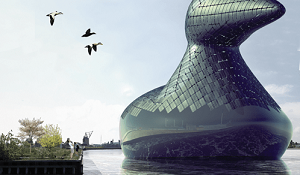A US-based organisation, LAGI, is offering US$21,000 to designers and artists who can create the best and most workable sustainable energy generators – that are also great to look at. By James Teo.
Melbourne, Australia. 3 February 2018. Every two years, LAGI (Land Art Generation Initiative) organises a global competition that calls for art installation submissions – with the twist that all entries have to include a clean energy-producing aspect that is capable of actual production, not just a one-off. Winners can win up to US$16,000 for the best entry.
The melding of art and sustainable energy could produce a beautiful machine - one that produces hundreds of millions of litres of drinking water. Image courtesy LAGI.
So far, LAGI has held design competitions in Abu Dhabi, Copenhagen, New York, and Santa Monica in California. This year’s event (LAGI 2018) is to be held in Melbourne, Australia, and submissions will be split into different technologies including photovoltaic, windpower, solar thermal, as well as newer technologies that capture energy from pressure, movement and ocean currents. LAGI says it is looking for two key elements: that submissions be a work of art, but also that they are technically feasible and would actually make a significant amount of electricity or power. The hour glass sculpture below, submitted in 2016, is designed to power about 1,000 homes, as well as being a work of art.
Old power is lovely
A Copenhagen submission for a massive generating hour glass. Image courtesy LAGI.
LAGI co-founder Robert Ferry explained that the role of the power generation plant has changed significantly over the last 100 years – and has left a significant hole in the aesthetic aspect of the sector. “Back at the start of the 20th century, there was no such thing as a high-voltage distribution grid, so small generators were placed right in [city centres],” he said.
“They were often [built] in beautiful, art-deco buildings that blended with the rest of the street. But once we were able to raise voltages, we got rid of central locations for power plants, because they were … polluting,” he explained. “And we got the power plants we think of today.” Ferry points to the current crop of massive coal, nuclear, gas, and even renewable energy plants built in sterile ex-urban structures, surrounded by practical yet ugly towers and distribution wires.
To further speed the transition to a clean energy economy and society, LAGI believes solar, wind, and other renewable power must be artfully incorporated into our public realm. It asserts that “renewable energy can be beautiful” and that if it is built to be good to look at, will be more likely to capture the imagination of the world.
Innovative design
The goal of LAGI is to accelerate a transition to post-carbon economies by providing models of renewable energy infrastructure that add value to public space, inspire, and educate too, all while providing power to thousands of homes around the world
One recent US entry in 2016 used tidal turbines to provide the energy required to pump seawater. This would then be used for distillation into drinking water, by using a stunning installation of Fresnel lens distillation towers on a breakwater. These were designed to use only solar power to produce up to 220 million litres of pure drinking water every year.
The Energy Duck plays on the appeal of the rubber duck, yet also produces power to light consumer homes. Image courtesy LAGI.
Another, from Denmark, used polycrystalline solar panels layered onto a duck sculpture that could float on water, yet could also power 40 to 50 homes. “And it’s done with off-the-shelf solar panels on a simple frame. We see yellow rubber ducks making appearances all over the world. We’re currently working to implement this one too,” said Ferry
LAGI says that the competition helps encourage professionals and students, engineers and artists to design structures that look beautiful and stimulating, yet can help meet increased demand for sustainable technologies in the future.
LAGI 2018 invites artists, architects, designers, landscape architects, scientists, engineers, and others to submit proposals for large-scale and site-specific public art installations that generate clean energy for a specific site in Melbourne. It is open to worldwide submissions, and is free to enter.
Building enthusiasm
Ferry said that LAGI is part of a drive to give environmental advocates “something to get enthusiastic about” when it comes to addressing CO2 emissions and climate change.
LAGI's Ferry: "renewable energy can be beautiful."
“You can only take so many rising sea level predictions,” he said. “It’s so overwhelming it shuts people off to action. [With LAGI] we want to give people something to run towards, rather than running from in the future.”
“Through the leadership of the Department of Environment, Land, Water, and Planning (DELWP), Victoria is setting an example for the world with a goal of zero carbon emissions by 2050. Melbourne, already one of the most sustainable cities in the world, is targeting net-zero by 2020,” noted LAGI in the run up to the event.
The brief and requirements are at the LAGI site, and all entries should be submitted by May 6 2018, with the winners will be announced in October. The first place winner will receive US$16,000 and the second place, US$5,000.



